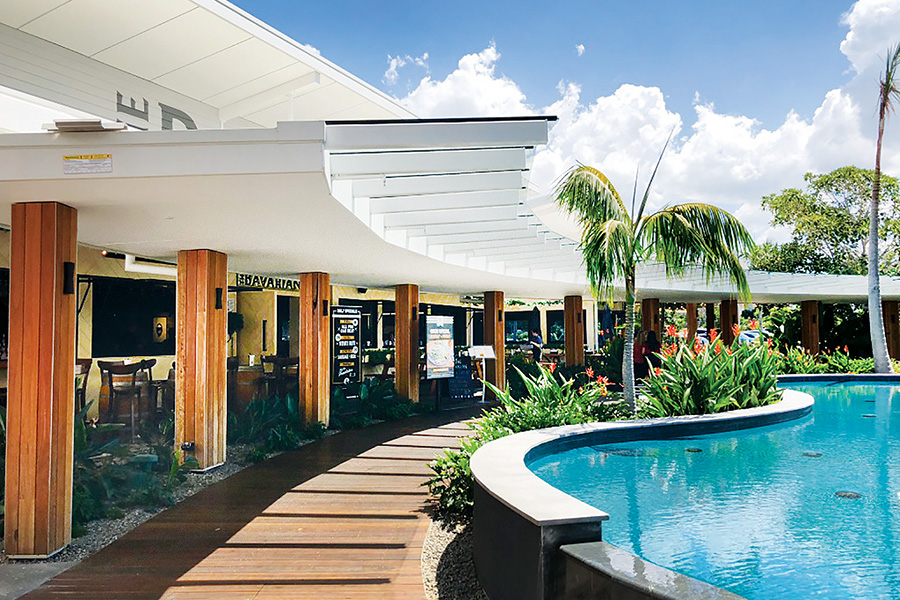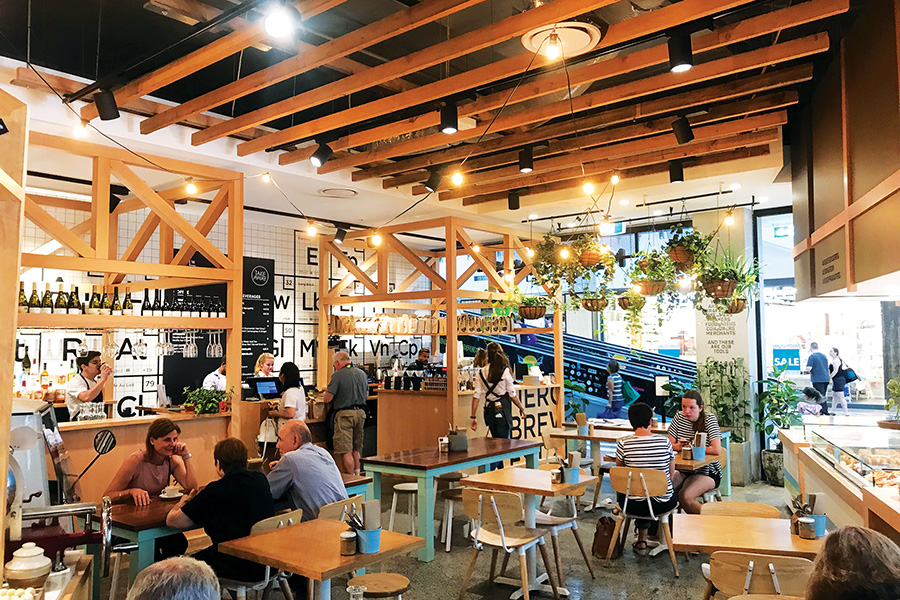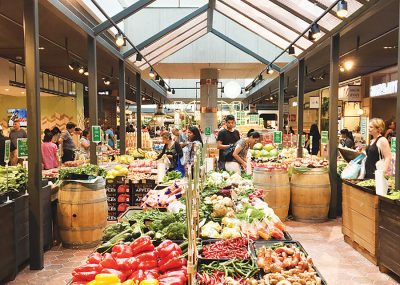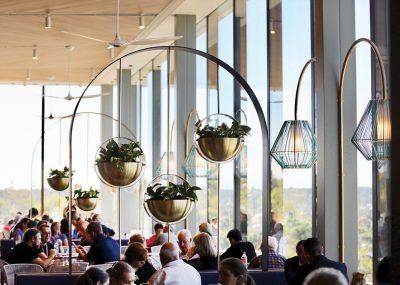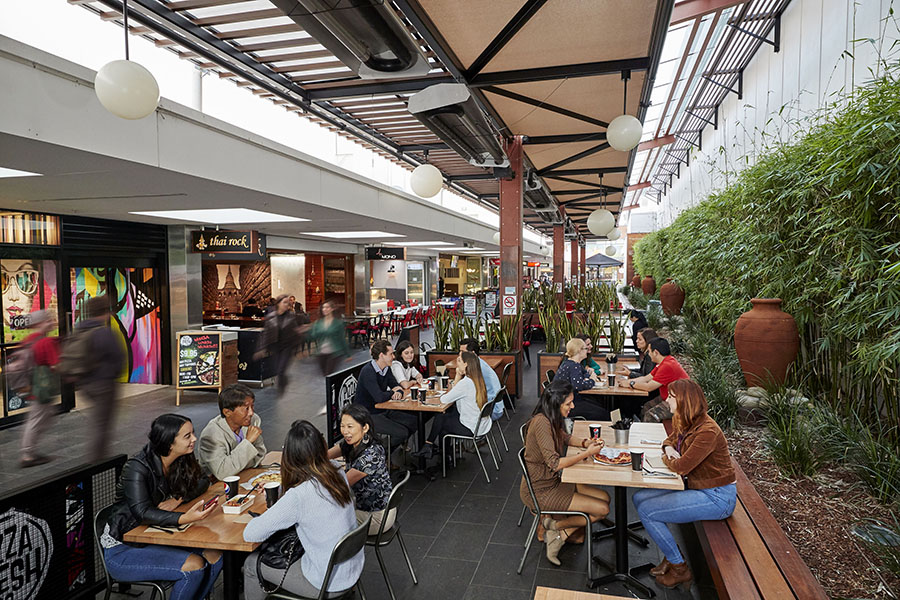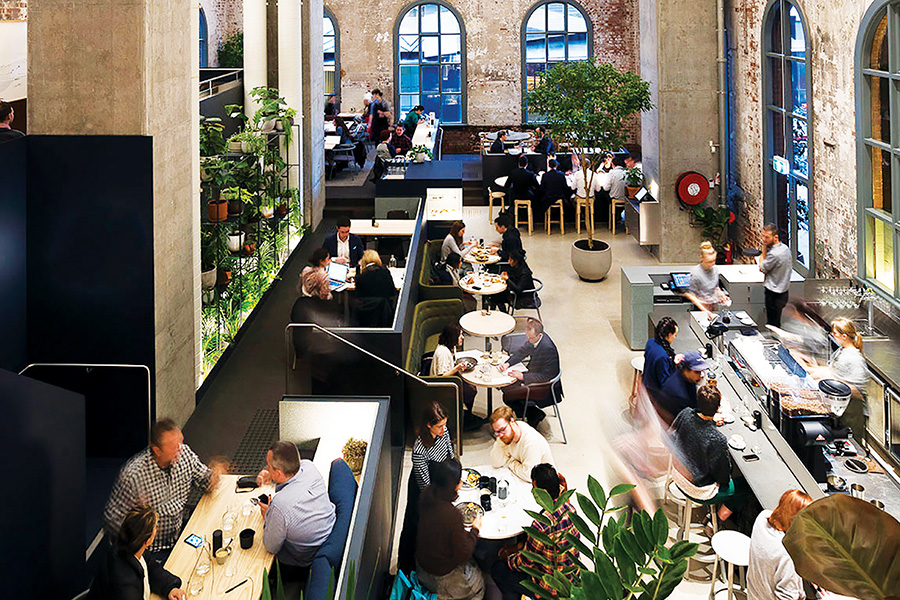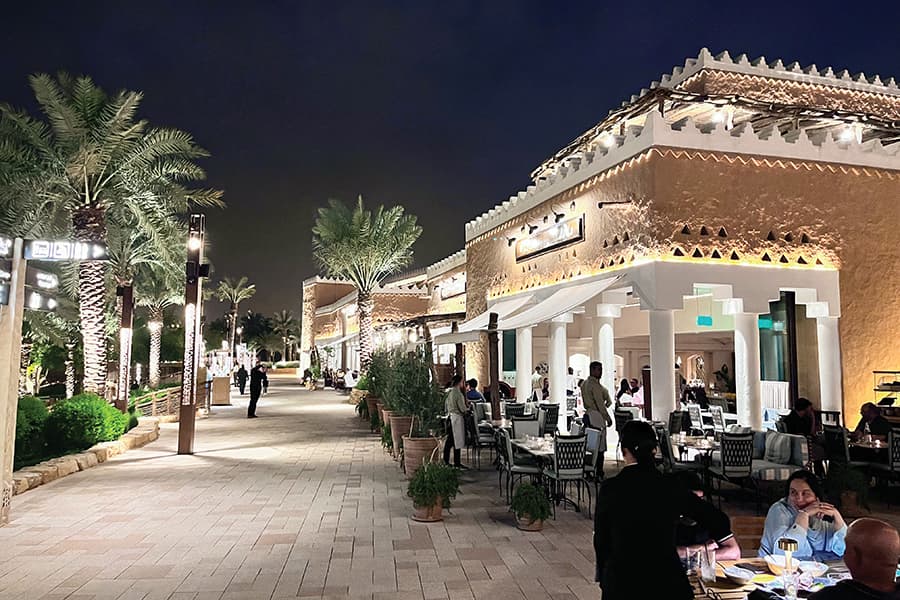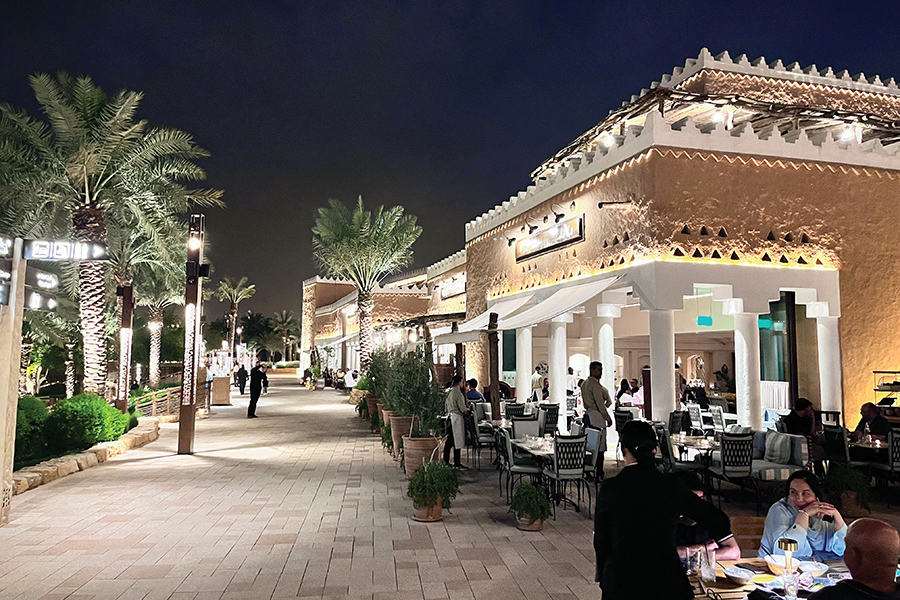In this two-part article, Francis Loughran looks at what the modern retail centre stands for from a food and hospitality perspective.
Is it possible that the modern lifestyle destination will drop the four-letter word MALL as it reinvents itself as a mixed-use project featuring food, hospitality, entertainment and other experiential asset-growth segments?
Looking across Australia and the world, it is clear that our shopping centres, malls, retail precincts, whatever you want to call them, are no longer single-purpose shopping malls; they are mixed-use projects offering so much more than product-focused retail.
First, let me start by confirming Wikipedia’s definition of a mall – “Mall may refer to a shopping mall, a strip mall, or a pedestrian street or an esplanade (a long open area where people can walk, which is mall’s original meaning).”
The new ‘lifestyle destination’ is much more than a place to shop, where you measure the enjoyment of your visit by the number of bags you carry back to the car. Those days are long gone. We now measure in positive and lasting experiences over products.
Today’s lifestyle destinations offer a specialised and sophisticated mix of hospitality, food, dining, retail, tourism, wellness, culture, leisure, entertainment, fun and social activities to deliver an all-encompassing experience and much more than any traditional ‘mall’ ever delivered.
Traditional anchors are slowly falling by the wayside across the globe. Landlords, as a result, are coming up with new and inventive reasons for people to come to their properties: residences, car dealerships, public libraries, government services, hotels, corporate offices and often a combination of all of those. While I’m not altogether happy with the word ‘lifestyle’, as it’s a very American phrase from the 1980s, we certainly need to come up with a name for these activity centres that encapsulates all of the scope and possibilities that these properties offer.
- Merchants of Ultimo, Broadway Sydney
For our younger readers of SCN, let me summarise the original thinking behind the mall’s success. Convenience was central to the conception of malls. They were first designed as one-stop-shops for consumers to buy everything in a single place. It wasn’t a new concept; shoppers in urban areas had been flocking to large department stores for more than a century. But the growth of suburbs in the mid-20th century created new needs. In many cases, suburbanites also needed places to hang out, and emerging shopping malls, from the very beginning, functioned as both retail destinations and town centres.
Today, they have evolved into thriving food, hospitality and entertainment destinations, trying hard to compete with the high-street cafe and restaurant culture that is driving strong growth in retail food in Australia and New Zealand.
Spending on food and beverages has been growing steadily for more than 36 years. In the year to June 1981 (the first full year for which data is available), the average Australian spent $375 on food catering. For the 12 months to June 2017, that figure had go
ne up to $2,191. The steady growth in the intervening period, averaging 5% per annum, overcame inflation and recession and was achieved despite a near doubling of the population. Australians’ love of eating and drinking outside of the home has known no bounds. Nor does it evidence any signs of plateauing.
During the past four years, food and beverage’s share of employee compensation has gone up from 6.0% to 6.5%. Given that this time period has seen relatively stagnant wage growth, it demonstrates that Australians’ love of eating out will be one of the last things on which people cut back significantly.
- Food Hall, The Glen Melbourne
- People are social creatures by nature, with hospitality ingrained in our way of life
Let’s face it, lifestyle destination malls, shopping centres, retail precincts and direct factory outlets no longer fit the criteria or mix of shops of the traditional mall. Today, they are externalised, built to five-star hotel standards, employ food and beverage managers, tourism directors, urban design architects and consist of beautiful chef-inspired food outlets and cafes. Whether developers recognise it or not, lifestyle destinations are in fact part of a bigger industry, the hospitality industry (food, beverage and accommodation), an industry that is changing as fast as the retail industry. Its unprecedented growth has been driven by many social and demographic factors including the following well-established industry drivers:
1. Wealth and income
From 1981 to 2017, Australians achieved average per capita growth in wages, after inflation, of 1.2% per annum. Combined with strong growth in the value of housing, the share market and superannuation, these factors have underpinned the growth in demand for more, and better, food and beverages.
2. Convenience
With consumers living increasingly busy lives, demand will be driven by their desire for convenient food and beverages. Cafes are expected to take some marketshare from restaurants as consumers move away from formal dining, choosing more convenient cafe-style meals and snacks.
3. Health
Consumer demand for healthier, premium quality food and beverages will also underpin industry performance. Businesses offering diverse menus with an emphasis on fresh, premium ingredients are expected to perform best as discerning consumers search for better quality on-trend cafes.
4. Competition
Fierce industry competition, particularly on price, will be the main factor limiting growth. Price increases for restaurant meals and take away and fast foods have moved closer to the CPI (Australia’s weighted average price increases), meaning that restaurants and take-away services have less room to add a mark-up to inflation.
5. Food and popular culture
The industry has benefited from the enormous rising food culture. Awareness of fashionable restaurants, cafes, food parks and bars is strong and further enhanced via online consumer review sites such as Urbanspoon and Trip Advisor. There is also a trend towards high quality, gourmet food, supported by the prevalence of cooking shows, such as Masterchef and My Kitchen Rules.
6. Different types of shopping
From online to mobileapps, the way we shop has more variables than ever before.
- Stockland Wetherill Park
Today’s lifestyle destination is capturing the customer’s attention by offering beautiful spaces to eat, drink, socialise, relax and spend.
Yes, we are in the business of food and spending on food consumed outside the home continues to rise globally. In order to capture today’s informed customer and their hard-earned money, they must be tempted by a number of ‘allurement’ factors. These include a beautiful space, a clean, secure and managed environment, a creditable food and beverage operator, quality food and excellent service. This standard has been created by ever increased competition and when it comes to the food business, the availability of more professional hospitality groups installing world-class concepts. These include groups such as Merivale Group, Nathan Toleman’s (Higher Ground, Australia) or the Bar Group in New Zealand who are raising the bar. Sydney based Merchants of Ultimo is also delivering experiential-based casual dining in Broadway Shopping Centre, Sydney.
Take Higher Ground for example. There are cafes, and then there are cafes by Nathan Toleman. You may not recognise his name, but if you’ve brunched in Melbourne in the past decade, you’ve likely been to one of his appealing venues. His most recent is Higher Ground, which opened in the CBD’s west end last year. Taking shape in a disused 18th century power station, the humming eatery boasts soaring 15m ceilings, 130 seats, attentive service and an eclectic, all-day menu with dishes such as spiced cauliflower scrambled eggs and confit saltbush lamb ribs. “It is, arguably, the most spectacular cafe in the country. But if it’s not your local, there’s no reason to despair. As a nation, we are spoiled for choice when it comes to exceptional cafes. The best of the new breed combined dinner-worthy fare with arresting interiors,” Megan Miller, Delicious.
Like the French bistro, the Italian trattoria or the English pub, the Australian cafe is an archetype that is now imitated worldwide. Hallmarks include communal tables, informed yet informal staff, Insta-ready food and, the clincher, standout coffee from baristas who are well-versed in their craft. Healthy competition in Australia pushes operators to do better.
- Nathan Toleman’s Higher Ground
Due to the success of these types of business outside the mall, beautiful spaces that are professionally styled and visually presented are the platform for the food destination success within retail centres and lifestyle developments around the world. During the past 12 months I’ve studied food and hospitality in more than 20 countries and it is clear, it is all about design driven, eye-catching spaces for all types of developments from retail centres through to pop-up sites.
Now is it working together?
Interior design, styling and visual presentation combined have created a platform from which the food, table top and service can all be elevated. We’ve moved well beyond the ‘good design’ of the 1990s when design was the icing on the cake, but the cake (delicious food, excellent service, smart table top and consistence) never existed. Now we must deliver the whole cake including good service, clean surroundings, enticing visuals and great food. In part two of the article, I will talk about the Styling 2020, which defines how our restaurants, cafes, food halls and food destinations will continue to use styling as a platform for creating strategic, focused, scalable and dynamic food destinations built on a story – examples can be seen at the Merchants of Ultimo, Broadway and the new Market Hall at The Glen Shopping Centre, Melbourne.
Furthermore, the ‘lifestyle destination’ of the future will specialise in certain retail categories and will clearly define what it wants to be famous for. Today’s lifestyle destinations are growing fast. These include Barangaroo, Chadstone, Eastland, Pacific Fair, Westfield Chermside, Westfield Century City, The Dubai Mall, Parque Arauco, intu properties plc, The Galleria, Abu Dhabi and Mall of Sweden, to name a few. They will continue to redefine what they want to be famous for in addition to being a great retail destination and that definition will include the experience delivered from food and hospitality.
Modern food and hospitality is and will continue to be an endless opportunity for mall developers and lifestyle destinations. It is not a predictable department store, major or mini major, supermarket or international bookstore. Food engenders belonging; belonging is powerful, why, because as social animals, we crave social connectivity. Food and hospitality destinations are now being planned to a criterion of fulfilling social and personal needs, senses, emotions, advocacy, by meeting unrecognised needs, fulfilling wants, and delivering satisfaction. Food and hospitality on our high streets and within our lifestyle destinations provide places to meet, socialise, do business, and spend quality time with family and friends. It’s all about people enjoying modern hospitality in our modern lifestyle destinations.
The business of food: people, profit, performance, positive-experiences
The business of food is all about profit, rent, and percentage rent and asset value growth. Competition is driving standards and diversity and the customer is not the only winner. Great sales equate greater rents and asset growth, however, maintaining sales is about consistency in food and hospitality, something shopping centre management is yet to learn about.
No consistency, no success
Food precincts, halls, markets and destinations are live-spaces. They need to be managed and represented each day as new and beautiful, styled, creative, welcoming, safe active community spaces and consistent. Image is everything when it comes to food.
In summary, part one confirms that malls have for some time now graduated beyond retail spaces; they are integrated multi-dimensional lifestyle destinations that connect with their many communities. Food and hospitality will define your project’s positioning statement and future success. The world’s new major malls, business clusters, waterfront developments and more than 50% of all redevelopments are dedicated to food and hospitality.


